In Abu Dhabi and Dubai the bottom line is be respectful of the local culture, be polite, and behave and dress accordingly; if it helps, imagine you’re visiting your Baptist aunt in the Texas Panhandle and you will be just fine.
Here in the United Arab Emirates (UAE),where turquoise sea laps the golden sands, a few decades ago only backwater fishing ports and pearl diving villages existed. The oil boom of the 1960s propelled the UAE into the modern era, but it was the bold, visionary planning of Emirates leaders to diversify into tourism, finance, and real estate that has transformed the country, most notably Dubai and Abu Dhabi, into a place heaving with wealth and luxury. Although endless beaches are the main draw for sun-starved winter tourists, high arts and culture are making rapid inroads, and cutting-edge, innovative architecture juts skyward in every direction, with the towering Burj Khalifa the most iconic sight.
My first stop is Saadiyat Island, Abu Dhabi, about a 20-minute drive from Abu Dhabi International Airport. Just half the size of Manhattan, this area is a natural wonderland fringed with sand dunes where every Spring endangered hawksbill turtles nests and elevated boardwalks protect hatching eggs from beachgoers. Bottlenose and Indo-Pacific humpback dolphins also frequent the clear waters, as do both bikini- and burka-clad visitors.
I check into the Rixos Premium Saadiyat Island Resort whose lobby features white marble walls and floors, baronial Venetian Glass chandeliers, splendid oriental carpets, and floor-to-ceiling sapphire-toned glass. This first impression sets the sumptuous tone for the rest of the resort unfolding around an impressive courtyard with towering, key-hole archways framing a private beach.

Saadiyat Island (Photo by Myroslava Bozhko)
My spacious, one-bedroom suite on the third floor opens onto a balcony with a sweeping view across the lawn fountain to the swimming pool. The décor is opulent Ottoman (Rixos is a Turkish company) highlighted with Aegean aqua and greens, mosaic tiles, colored glass, and plush fabrics. The immense bathroom with L’Occitane amenities features a giant soaking tub that closes off with a frosted glass sliding panel.
While some are content to pass a holiday lollygagging poolside reading a book, I need more action, so I head for the well-equipped gym to press weights, clock in cardio time on the bikes, and then slip into an intermediate yoga class. Cross-fit, TRX, Tabata, Pilates, yoga, and other classes are held throughout the day. Before dinner I laze in the Ottoman-inspired spa with steams rooms, sauna, hammam, jacuzzi, and a courtyard swimming pool.
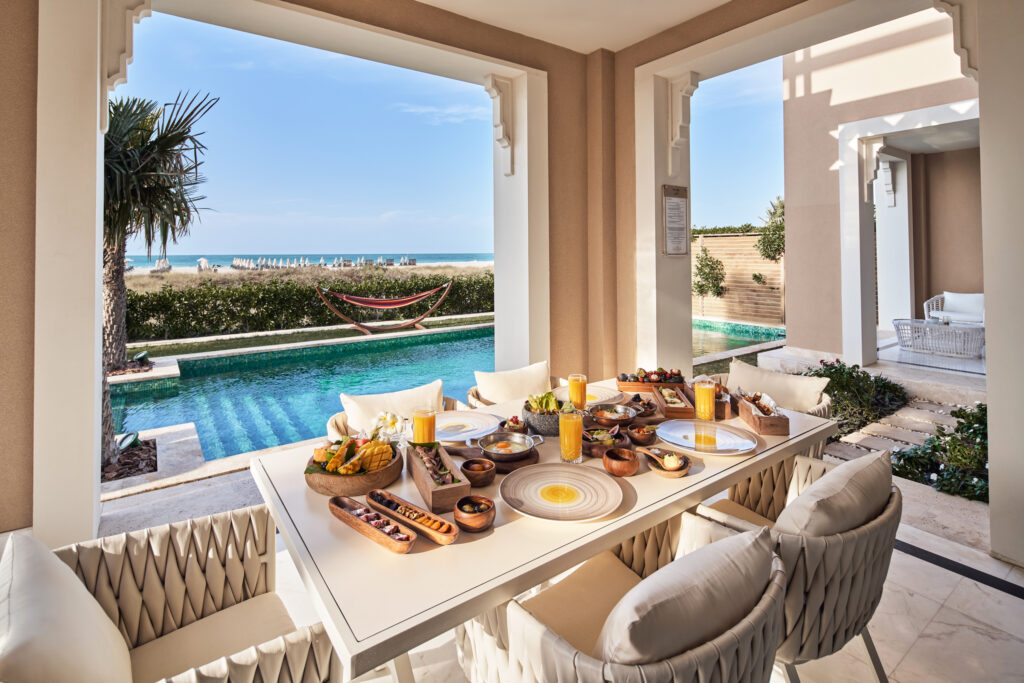
Luxury Villa Within Rixos Premium Saadiyat Island at Club Privé by Rixos Saadiyat Island (Photo by Erdogan Kabakci)
In recent years the Gulf States have become engaged in a cultural competition, with Saadiyat Island as the UAE’s arts and educational hub. The Sorbonne, NYU, and Boston’s Berklee College of Music all recently opened campuses there, as did the Cleveland Medical Center. In the line-up to follow in the footsteps of the Louvre Abu Dhabi are the international arts worlds big hitters: a Gehry-designed Guggenheim (set to open in 2024); the astonishing Sheikh Zayed National Museum by Norman Foster that resembles a falcon’s wings; and a performing arts center by the late Zaha Hadid, modeled on a writhing tangle of ectoplasm.
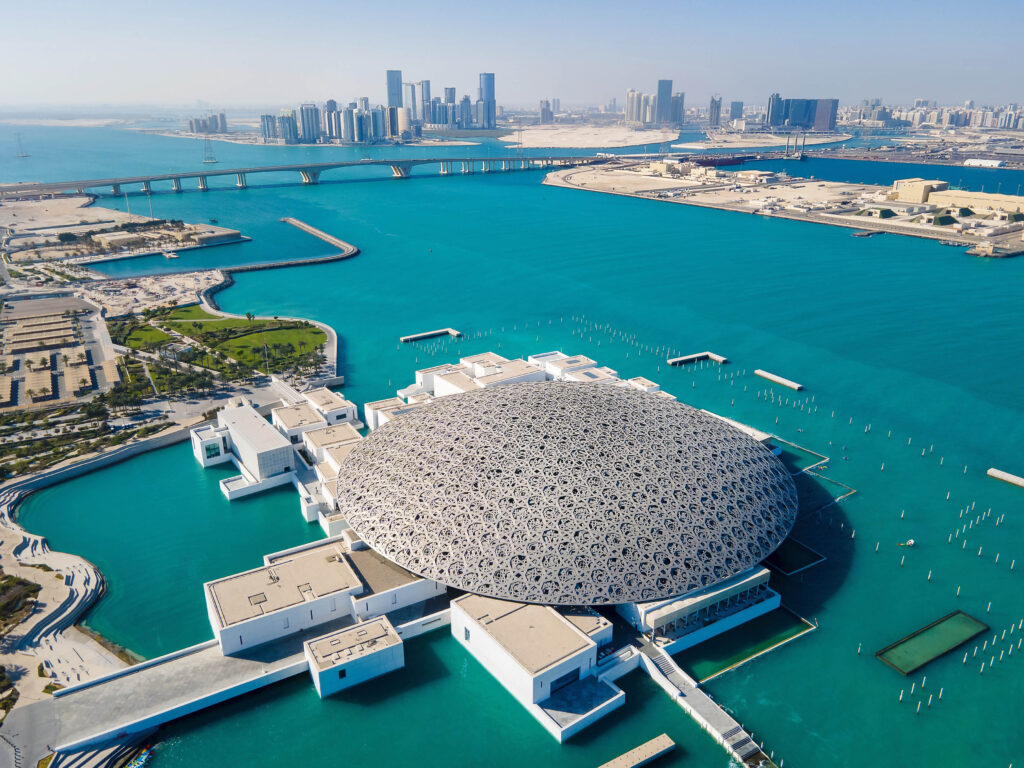
Louvre Abu Dhabi Aerial With Cityscape (Photo by Creative Family)
I’ve visited the world’s major museums and must say that the Louvre Abu Dhabi has now nudged out the Tate London as my all-time favorite. Dreamed up by Jean Nouvel, the structure itself is a feat of genius design and engineering. The huge dome filters light through multiple layers of geometric patterns into the shaded galleries, with startling views of the incandescent turquoise water surrounding the complex; you can even rent kayaks to paddle around and under the museum.
In the sun-dappled interior you embark on a journey through time and civilizations, exploring treasures from the world over. Rather than chronologically, the collections of paintings, sculpture, and artifacts are arranged thematically, encouraging the discovery of cultural similarities that reinforce our shared humanity.
For example, in the room titled “Challenging Modernity,” three paintings by Josef Albers, Mark Rothko, and Sayed Haider Raza are displayed side by side. A connoisseur of Rothko unfamiliar with Raza, the Indian painter trained in France, will marvel at their striking harmony, allowing viewers to trace the artistic influence from Germany to the United States to India. The art is world-class, and though Caillebotte, Van Gogh, Cezanne, and Renoir are displayed, mercifully, there’s no show-stopping David or Mona Lisa to hog the limelight.
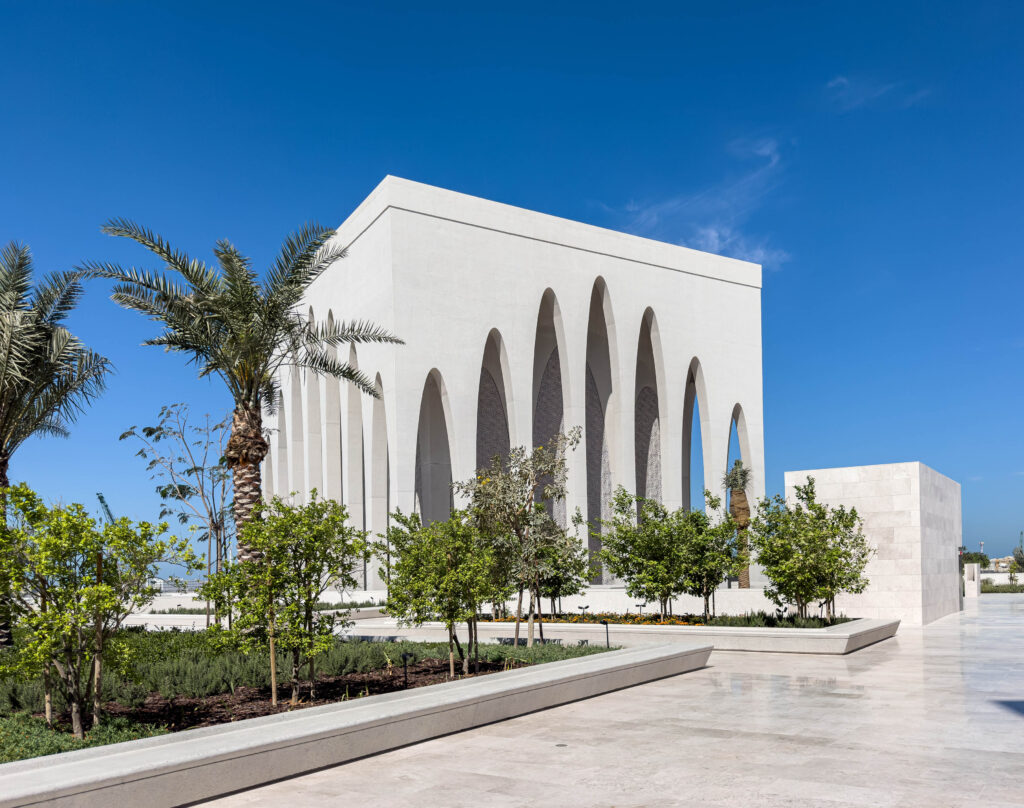
Abrahamic Family House (Photo by Heinrich van Tonder)
A ten-minute stroll from the Louvre is the newly opened Abrahamic Family House, an interfaith complex, designed by renowned Ghanaian architect David Adjaye. Visitors enter through an underground passage emphasizing the shared roots and common ancestor of the three Abrahamic faiths, with the monumental brilliance only fully revealed upon emerging into the sun-drenched spaces and gardens connecting three colossal white cubes. The Moses Ben Maimon Synagogue honors the 12th-century Jewish philosopher and is the first purpose-built synagogue in the UAE.
Facing Mecca, the Imam Al-Tayeb Mosque is encased in a delicate latticework, called mashrabiya, diffusing the harsh desert light. Oriented to the rising sun, the church is dedicated to the peace-aspiring St. Francis of Assisi. I settle into a pew towards the back, admiring the unusual wooden beam ceiling. When a lone man in front of me stands up to leave and nods in my direction, it takes me a beat to realize it is the actor Idris Elba, apparently a frequent visitor to the UAE.
While textured stone and filtered light dominate, the leitmotif of purifying water in all three religions is explored through ponds, pools, baptismal font, mikveh, and mosque ablution basins. The economy of design and multisensory experience of the Abrahamic Family House achieves an astonishing level of sophistication, nourishing the body, mind, and spirit. Having been raised Catholic and just flown in from the strife in Israel, I am particularly moved by this aspirational interfaith project.
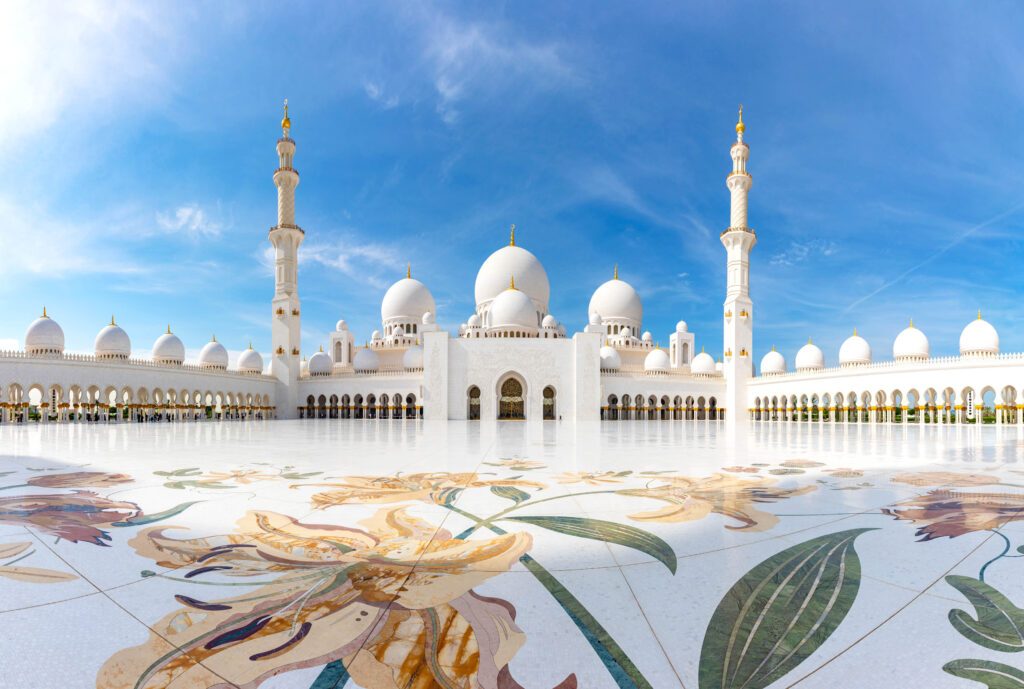
Sheikh Zayed Grand Mosque (Photo by Brunocoelho)
In a country with many superlatives, here’s one more: the Sheikh Zayed Grand Mosque, the world’s third largest, is named after and also the resting place of the nation’s founder. Blue tiled reflective pools surround the massive floral inlaid marble courtyard. The interior is resplendent with the world’s largest crystal chandeliers, the world’s largest handmade carpet, and inlay work with gold and semi-precious stones (lapis, carnelian, jade, rose quart). This breathtaking structure rivals the Taj Mahal for the most impressive building I’ve ever seen. When I first visited eight years ago, I practically had the place to myself; now there’s a river of visitors, so come early morning, or in the evening when it’s all lit up.
On the fourth morning of my visit to the UAE, I took a cab to Dubai to begin the next part of my journey of discovery. While in Dubai, I mostly travel by taxis, which are abundant and found at stands at malls and hotels, or you can flag one down on the street. Reasonably priced, they’re the most expedient way to get around, except during rush hour when you’d be better off on the metro system linking the city’s key spots (buy a Nol pre-paid smartcard usable on the metro, tram and bus network.) Uber and local ride-hailing service Careem are also popular alternatives. Though I saw few cyclists, Byky bike share stations dot the tourist hub and are a fun way to take in the 11 km-long route along the Palm Jumeriah crescent.
Feeling the need for a kitschy change of pace from all the amazing art and architecture the UAE has to offer, I decide to visit Dubai Miracle Garden, the world’s largest flower garden with over 60 million blooms. Strolling through floral heart arches, there’s windmills, animals, quaint houses, and castles entirely slathered in shades of pink, purples, reds, and yellows. There’s even a full-size Emirates Airbus A380 covered in 500,000 flowers, plants, and white petunias.
Topiary here include Goofy, Donald and Daisy Duck, and a 60-foot Mickey Mouse weighing 35 tons. It takes 200,000 gallons of the city’s recycled wastewater daily to maintain, and due to the desiccating summers Miracle Garden is only open from October to April, which are also the recommended months for visitors to the UAE (otherwise, you’ll simply whither in the 110–125 degree summer heat).
Just across the road beckons the equally delightful Dubai Butterfly Garden (natch, the world’s largest…) with some 15,000 butterflies of 26 species flitting about. There’s nothing like having the iridescent creatures bestow their blessing by landing on your hand or head. Children were in thrall, though one inexplicably terrified young girl shrieked and begged her dad to get her out of there; he finally did when she tried to stomp on one; not something you’d want to see.
Late afternoon on my third day, the high-rises slowly recede in the Land Rover’s rear view mirror as I drive east to the Dubai Desert Conservation Reserve. Passing through dunes dotted with Ghaf groves, we arrived at a remote oasis lake for a falconry evening with, Platinum Heritage a tour company that offers a variety of desert experiences. More than a mere sport, the cherished tradition of falconry was essential for Bedouin survival, and now the national icon appears on their currency. A well-trained falcon is valued up to $50,000 and is a status symbol.
Perched on guide Tariq’s gloved fist was a hooded Saqr Falcon, a large species with a snowy white head. Tariq picked up falconry from his father, who learned from his father, going back generations, and he is proud that his 7-year-old son is now enthusiastically working with birds. He showed off several traditional and modern training techniques; drones dragging bird decoys are now used for speed flight training. After the demonstration we each had a few minutes handling a smaller Sooty Falcon. As the sun set over the dunes, we enjoyed sparkling juices and then a six-course culinary journey. The excursion concluded with captivating entertainment of fire twirlers and acrobatics
It’s difficult to conjure to mind local life before the oil boom, but at the Heritage District on Dubai Creek its previous incarnation as a fishing village is preserved. The centerpiece is Al Fahidi Fort, built in 1787 and once the monarch’s residence, in 1971 it was renovated as Dubai Museum. Rising above many restored buildings housing mosques, old homes, and other museums, you will see traditional wind towers, an indigenous, energy-free form of natural cooling that are making a comeback, even in some new residential housing developments.
Exploring the winding alleys of the Heritage District, I stopped in the Calligraphy House that specializes in the art form of Arabic writing, and I had an artist write my name in flowing script. Afterwards, I took an abra (a traditional wooden boat) ferry across the Dubai Creek to test out my haggling skills in the spice, garment, and gold souqs. In the jewel market I found a loose stone I liked, and after back and forth, feigned annoyance, a glass of tea, walking away, being beckoned back (which is all part of the fun), we finally settled on an agreeable price for a small sapphire for my necklace.
If you like to shop, Dubai has perfected the art of the mall, the de facto air-conditioned town commons, as a wonderful place to hang out in with family and friends. Even if you never swipe a credit card, you’d be remiss not to gawk about in Dubai’s two gargantuan shopping complexes.
The Mall of the Emirates houses five hotels, 650 shops, over 100 restaurants and cafés, as well as the Magic Planet family entertainment center, the Dubai Community Theater and Arts Centre, and the implausible Ski Dubai, the world’s largest indoor snow park and ski slope—replete with penguins! Hordes of local kids suited up for ski and snowboard lessons, presumably to eventual graduate to the real deal in Switzerland or Colorado. Despite a recent knee replacement, my avid skier friend Rob was not going to miss this opportunity; purchasing a two-hour pass, he repeatedly swooshed down the 400-meter runs ranging from bunny slopes to black diamond, while I watched through the plate glass windows sipping hot chocolate.
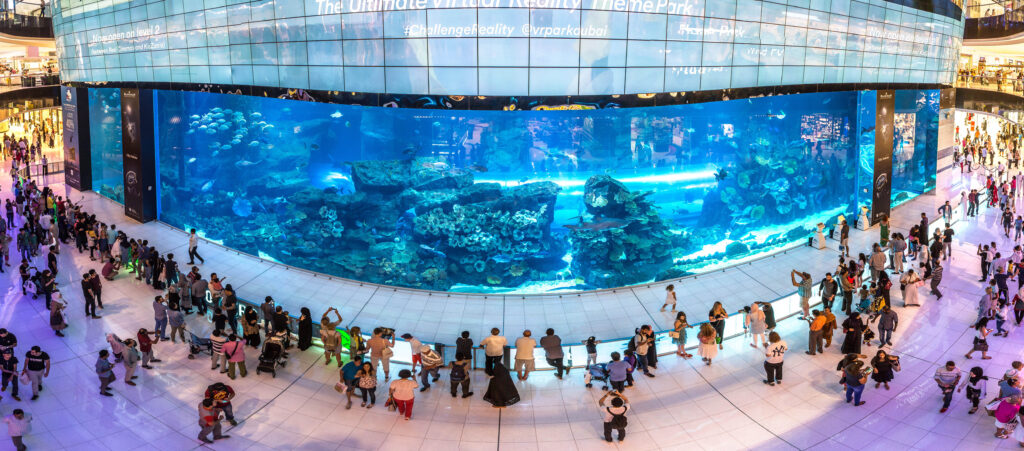
Panorama of Aquarium in Dubai Mall, The World’s Largest Shopping Mall (Photo by Sergii Figurnyi)
Not to be outdone, Dubai Mall includes 1,200 shops and is the most visited building on the planet. Every international brand beckons, but shopping is the least of it. We walked through the underwater tunnel at the Dubai Aquarium & Underwater Zoo showcasing some 300 species of marine animals, including sharks and rays. There’s a 22-screen cinema, a haunted house, and an Olympic sized skating rink. There is also a four-story cataract studded with sculpted pearl divers that is impressive. The cascading water creates a visual illusion making it seem that the divers are moving instead of the water. Just outside the mall, Dubai Fountain on a 30-acre lake is the World’s largest choreographed fountain system. This gigantic installation is 902 feet long and shoots water up to 500 feet, undulates, shimmies, and arches to classical arrangements, contemporary Arabic, and world music.

The Dubai Fountain is the World’s Largest Choreographed Fountain System. It is Set on the 30-Acre Man-made Burj Khalifa Lake (Photo by Sorbis)
To circumvent the long queue waiting to ascend the 2,722-foot-tall Burj Khalifa, we opted for premium tickets. Pre-booking online will save you money and provide for immediate entry during non-peak hours. After tea and fresh dates in the beautiful VIP waiting room, we were whisked up to the level 154 (the highest floor for visitors) into a tranquil lounge with 360-degree views of the dazzling lights of the city. The staff offered champagne, beers, soft drinks, and delicious snacks. It is often dusty or cloudy in the city, but we lucked out; the visibility was so clear that a hostess pointed out the distant shores of Iran 95 miles away.
Dubai has also turned upending world records into something of a sport, with another added to the list recently: The Link at the One&Only One Za’abeel hotel boasts the world’s longest cantilever building, and longest suspended infinity pool connecting the 25th floors of the dual towers. We splurged for a day pass to hang poolside replete with sunken seating, swim-up bar, and ultra-luxe private cabanas with unparalleled views. The pass is partially redeemable for cocktails and dining at Tapasake restaurant, whose extensive menu features signature Japanese and Peruvian dishes such as sushi and sashimi, crisp tempura, and marinated fish and meats prepared over hot coals. Once One Za’abeel is fully up and running, it also promises to become the culinary epicenter of the city; its eleven restaurants will boast 29 Michelin stars, the most under one roof anywhere in the world.
Speaking of food: During the month of Ramadan Muslims abstain from eating and drinking from dawn to dusk. Though you’re free to consume whatever you want within dedicated areas in your hotel, in your room, and in the public restaurants with blacked out windows. While this may put a kink in your culinary adventures, Ramadan can also be a culturally enriching time to visit; the languid mornings transform into festive nights, where the malls fill with boisterous diners, dance, and celebratory displays. Since Ramadan follows the lunar calendar, the dates shift every year, and whether you prefer to avoid or enjoy the holiday it’s important to check out the dates while planning your trip.
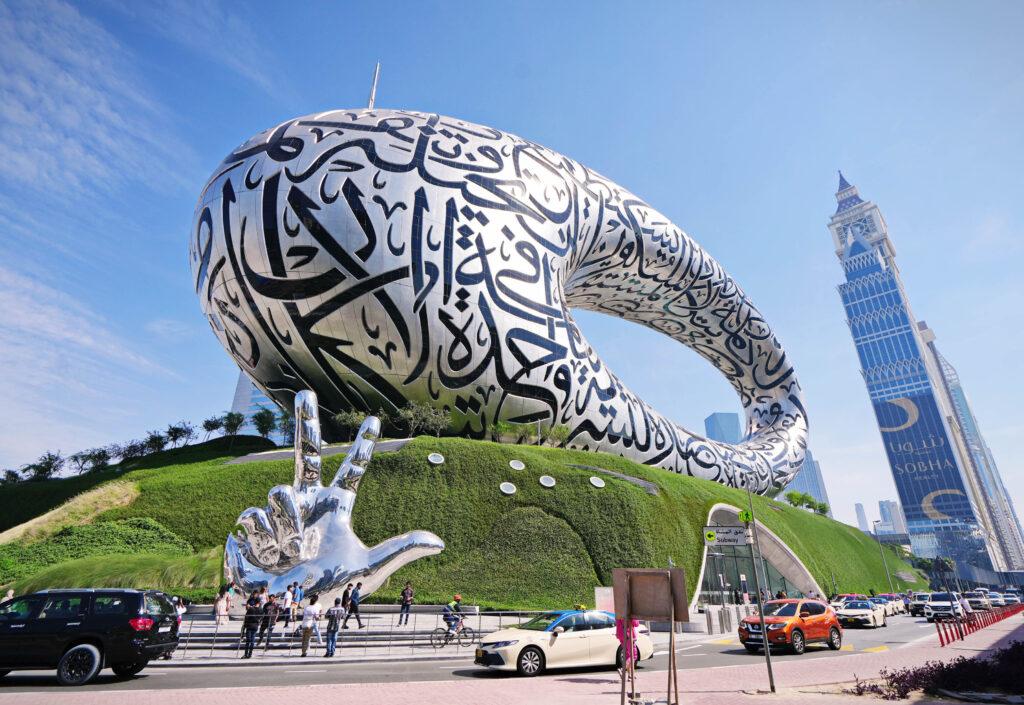
Museum of the Future in Dubai (Photo by Mike Dotta)
When Dubai’s Museum of the Future, an astonishing 77-meter-tall stainless-steel torus, opened two years ago it instantly became another iconic landmark. In the cavernous lobby, a penguin-shaped silver drone swims through the air and a futuristic elevator whisks visitors to a collection of interactive experiences imagining the near-future of health care, housing, agriculture, arts, and humanity itself. Both inside and out, the giant Arabic calligraphy, designed by Emirati artist Mattar Bin Lahej, covering the walls functions as windows as well as decoration. The script is based on a quote from Sheikh Mohammed: “The future belongs to those who can imagine it, design it, and execute it. It isn’t something you await, but rather create.” Which perfectly sums up the improbable reality that Dubai and Abu Dhabi have become; where once only the turquoise sea lapped the golden sand, it’s now the cultural, tourism, and financial center of the Middle East.
To Dubai or Not Dubai, That Is The Question
As a queer person, you’d only be circumspect to wonder if traveling to the UAE is wise considering that on the books: in flagrante delicto homosexual acts are punishable up to 14 years (or even death); donning your skimpy Kate Barton cut-away mini at the Dubai Mall could land you a year in prison; and public displays of affection (whether straight or gay) are strictly taboo and subject to fines. Chilling sounding, yet the US State Department reports that there has not been a single arrest, prosecution, or punishment for same-sex activity in the UAE since at least 2015.
It’s built into the culture that if it can be interpreted in a way that can be ignored or willfully overlooked, the authorities will turn a blind eye to “immoral” behavior by foreigners. However, when something can’t be ignored, you may even be charged with offenses that few would imagine were crimes: flipping the finger while driving, accidentally brushing against someone in a crowded bar, spitting in public, etc.
In attempt to reform its international image and encourage an already booming tourism industry, in 2018 openly-gay Ricky Martin performed at the Dubai Jazz Festival, and more recently Beyonce appeared in Dubai promoting her empathically queer Renaissance album; though ironically Pixar’s animated Lightyear was banned because of a same-sex kiss.
Gay, lesbian, and queer expats can be seen at the beach, museums, malls, restaurants, etc., and with a foreign population of nearly 90%, and the demographic anomaly that males make up 68.58% of the population…well, you know there’s a lot of homo hanky-panky going on. Dubai touts itself as the Las Vegas (minus the gambling) of the Middle East where booze- and sex-deprived Arabs flock to get their naughty fix. As the saying goes: What happens in Dubai, stays in Dubai….as long as you’re discrete.
Prior to my trip to the UAE, I researched the legal issues and cultural norms. I also began wrangling up gay guys on Grindr. The country’s single Internet provider employs a proxy server which restricts access to websites, blogs, and chat rooms that flout the country’s moral values. These include dating and marriage sites, LGBTQ issues, porn sites, gay apps, and weirdly, anti-fox hunting comments. To access Grindr, Scruff, Daddy Hunt, etc. you must download a VPN on your phone BEFORE arriving in the UAE. Though there’s few reports of prosecutions, many conceal their identity in gay chat rooms, one of whom was a man I met named Victor.
The 37-year-old hails from Colorado, has worked for three years as an architect, and lives with his partner, from Kazakhstan, who works in the hotel industry. They met online several years ago, and cohabitate in a flat near central Abu Dhabi. Though circumspect in public, many of their expat co-workers have no issue about their proclivities. The couple’s social life revolves around soirees at the homes of their circle of gay friends (with the exception of one older Emirati man, they’re all expats) and they occasionally organize overnights to further-flung corners of the UAE. Except for the broiling summers, they’re fairly content living here because of the decent salaries, affordable living, immaculately clean city, and zero crime.
Occasionally they go out on the town, and while “gay” establishments per se do not exist, dozens of hotel bars, rooftops, restaurants, and clubs in Dubai and Abu Dhabi attract gays. Popular ones are: Bar 44 offers amazing views of Dubai and the Jumeirah Palm from a laid-back hangout atop the Grosvenor House; Zero Gravity with a gorgeous infinity pool and DJ nights every weekend; and the lively X-Bar at the Excelsior Hotel located in the heart of old Dubai. Victor said that it’s not uncommon to see Pakistani and Filipinos cross dressing, and they’re often not particularly discrete.
Additionally, every week-end the locations of underground club parties are released via Grinder and other apps, apparently with little fear of repercussions. We asked Jake, a friend’s gay brother who has lived in the UAE for several years, to keep us informed, and sure enough Friday morning a phone ping announced a gathering at 10 P.M. Tired as we were, we spruced up and taxied to central Dubai where we met up with Jake. Stepping off the luxury hotel elevator into the roof-top bar there were some 100 expat men, mostly over 35, chumming it up; everyone seemingly eager to strike up conversations with strangers.
Jake explained that even though you’re among friends at these gatherings, it’s advised to always imbibe with moderation, and keep your wits about you. And under no circumstance ever try to bring drugs of any kind into the UAE. Drugs will not be tolerated here.
Though it’s unlikely that an upscale hotel with their mostly international staff would concern themselves with your private life, an economy hotel might possibly only let a male couple book a room with twin beds, so just play along and push them together if need be. My friends David and Samuel who visited UAE the month before, had researched reputedly “gay-friendly” hotels and booked a room at the plush Hilton situated near Dubai Marina on Jumeirah Beach, and felt perfectly comfortable and had a great time. For a more romantic getaway there’s the Polynesian-style Sofitel Palm Resort and Spa set amidst lush, tropical grounds; and the extremely affordable, but comfy, Bonvoy Aloft Me’aisam with gym, pool, and sundeck.
There’s much in the UAE to be admired, but as in every culture the flip side to the positives are often hypocritical negatives. With the UAE the burgeoning epicenter of the entire Middle East, it would be a shame to miss out. The caveats being, if you’re unable to contain your fabulous rainbow self, or you’re the irrepressible activist type itching to test the waters, then by all means save yourself some grief and instead book a flight to Amsterdam or Bangkok. The bottom line is be respectful of the local culture, be polite, and behave and dress accordingly; if it helps, imagine you’re visiting your Baptist aunt in the Texas Panhandle and you will be just fine.
You May Also Enjoy
Discovering Kuala Lampur’s Gay Scene
Ludovic Zahed One Of The First Openly Gay Muslim Clerics In The World
LUDOVIC ZAHED ONE OF THE FIRST OPENLY GAY MUSLIM CLERICS IN THE WORLD


